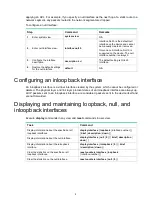
13
To avoid dropping packets on a link, you can enable generic flow control at both ends of the link.
When traffic congestion occurs at the receiving end, the receiving end sends a flow control (Pause)
frame to ask the sending end to suspend sending packets. Generic flow control includes the
following types:
•
TxRx-mode generic flow control
—Enabled by using the
flow-control
command. With
TxRx-mode generic flow control enabled, an interface can both send and receive flow control
frames:
When congestion occurs, the interface sends a flow control frame to its peer.
When the interface receives a flow control frame from its peer, it suspends sending packets
to its peer.
•
Rx-mode generic flow control
—Enabled by using the
flow-control receive enable
command. With Rx-mode generic flow control enabled, an interface can receive flow control
frames, but it cannot send flow control frames:
When congestion occurs, the interface cannot send flow control frames to its peer.
When the interface receives a flow control frame from its peer, it suspends sending packets
to its peer.
To handle unidirectional traffic congestion on a link, configure the
flow-control receive enable
command at one end and the
flow-control
command at the other end. To enable both ends of a link
to handle traffic congestion, configure the
flow-control
command at both ends.
Configuration restrictions and guidelines
This feature is not supported on 10-GE interfaces operating at 1000 Mbps on the following interface
modules:
•
FD interface modules: LSQM1GP40TS8FD0, LSQM1TGS24FD0, and LSQM1XPT12TSFD0
•
FE interface modules: LSQM1TGS48RFE0
Configuration procedure
To enable generic flow control on an Ethernet interface:
Step
Command
Remarks
1.
Enter system view.
system-view
N/A
2.
Enter Ethernet interface
view.
interface interface-type
interface-number
N/A
3.
Enable generic flow
control.
•
Enable TxRx-mode
generic flow control:
flow-control
•
Enable Rx-mode generic
flow control:
flow-control receive
enable
By default, generic flow control is
disabled on an Ethernet interface.
Enabling EEE on an Ethernet interface
With Energy Efficient Ethernet (EEE) enabled, a link-up interface enters low power state if it has not
received any packet for a period of time. The time period depends on the chip specifications and is
not configurable. When a packet arrives later, the device automatically restores power supply to the
interface and the interface restores to the normal state.
Configuration restrictions and guidelines
This feature is supported only on copper ports on the following interface modules:
•
FD interface modules:













































